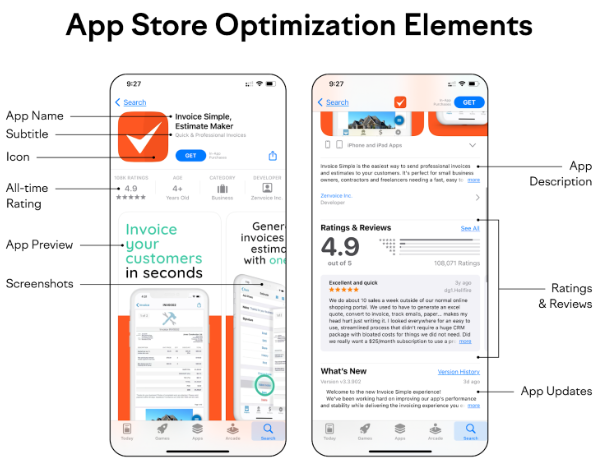App Store Optimization Guide
In the rapidly evolving world of mobile applications, App Store Optimization (ASO) has emerged as a crucial strategy for app developers and marketers. ASO is an ongoing process aimed at improving an app’s ranking and visibility within app stores, ultimately making it easier for users to discover and download. In this blog post, we will explore the significance of ASO, the key elements to focus on, and a step-by-step guide on how to optimize your app effectively.
What is App Store Optimization?
App Store Optimization, also known as app store SEO, app search optimization, or ASO marketing, is a strategic approach to enhance an app’s presence in app stores. The primary goal is to increase app downloads, but ASO can also contribute to improved brand awareness, increased user engagement, and the accumulation of positive reviews and feedback. While the Apple App Store and Google Play are the major players, ASO practices can extend to other platforms like the Amazon Appstore, Samsung Galaxy Store, and Huawei AppGallery.

Key ASO Elements
The specific fields and ranking factors for ASO may vary across different app stores, but common elements include:
- App Name or Title: The first and most crucial element users see in search listings.
- Keywords: Utilizing relevant keywords in the app title, subtitle, and a dedicated keywords field (Apple App Store only).
- App Description: Crafting engaging and informative descriptions that highlight the app’s features and benefits.
- Downloads: The number of downloads impacts the app’s visibility and ranking.
- Ratings and Reviews: Positive reviews and high ratings enhance the app’s credibility and visibility.
Updates: Regularly updating the app indicates ongoing improvement and positively influences rankings.
Why is App Store Optimization Important?
ASO is vital because it provides control over an app’s visibility and discoverability in a highly competitive app store landscape. A significant 82% of users discover apps through app store browsing or recommendations, emphasizing the importance of a strong ASO strategy. Without optimization, an app’s fate relies on the app store’s search engine and an element of luck. Continuous ASO is indispensable for ensuring an app’s success in its primary marketing channel.
How to Do App Store Optimization?
Initiate your ASO strategy with the following steps, keeping in mind the nuances between the Apple App Store and Google Play:
1. Optimize Your App’s Title and Subtitle
The app title is a critical element for both major app stores, limited to 30 characters. Utilize relevant keywords, maintain readability, and consider the use of a subtitle (Apple App Store) for additional context.
2. Add Keywords (Apple App Store Only)
Leverage the keywords field in the Apple App Store (limited to 100 characters) to include relevant terms. Test different keywords and combinations regularly to optimize for search.
3. Write Engaging App Descriptions
Craft compelling short and long descriptions, incorporating keywords naturally. Although Apple’s long description may not directly impact rankings, it influences user perception and, consequently, downloads.
4. Add Compelling Visual Elements
Utilize screenshots, videos, and app previews effectively to showcase your app’s functionality and value. Adhere to guidelines for the number of visual elements allowed in each store.
5. Encourage Reviews and Ratings
Positive reviews and high ratings contribute significantly to an app’s visibility. Strategically prompt users for feedback after positive interactions and use alternative channels for negative feedback.
6. Maximize Downloads
Improve your app’s conversion rate by continuously optimizing various elements on your app store page. Monitor changes and strive for a user-friendly experience to increase downloads.
7. Update Regularly
Regular updates signal to app stores and users that your app is evolving. Use the update descriptions to incorporate keywords and inform users about new features or improvements.
8. Monitor Results and Keep Testing
Utilize analytics tools to monitor keyword rankings, downloads, and reviews. Test different elements regularly, keep a log of changes, and refine your strategy based on performance.
9. Go International
Expand your app’s reach by localizing it for different regions and languages. Consider cultural nuances and present your app in a way that resonates with diverse audiences.
10. Incorporate Other Marketing Channels
While ASO is crucial, leverage other marketing channels like SEO-driven websites, email marketing, social media, and paid ads to capture a broader audience throughout the buyer’s journey.
In Conclusion
App Store Optimization is an ongoing and essential process for success in the dynamic app store environment. Integrating ASO into your overall marketing strategy requires continuous fine-tuning and vigilant monitoring. As the app landscape evolves, competitors emerge, and store guidelines change, consistent application of ASO techniques outlined in this guide ensures your app remains visible and successful. Stay proactive, adapt to changes, and keep optimizing to enhance your app’s visibility and chances of success in the ever-evolving app store ecosystem.


